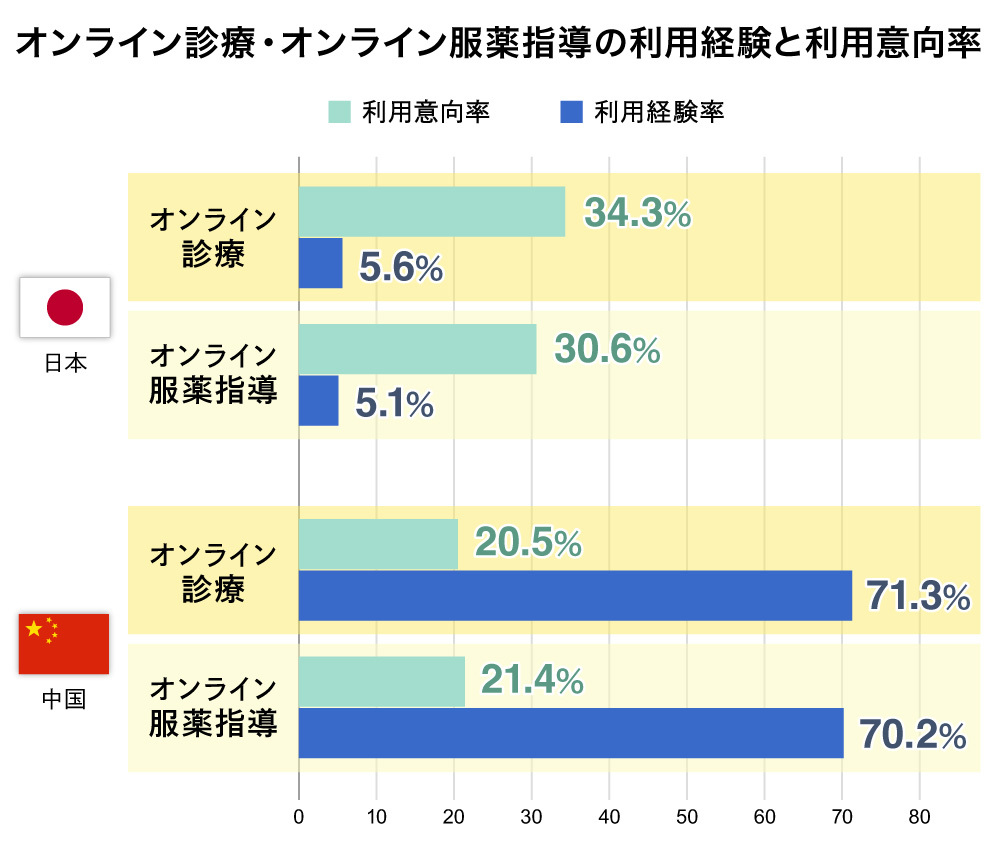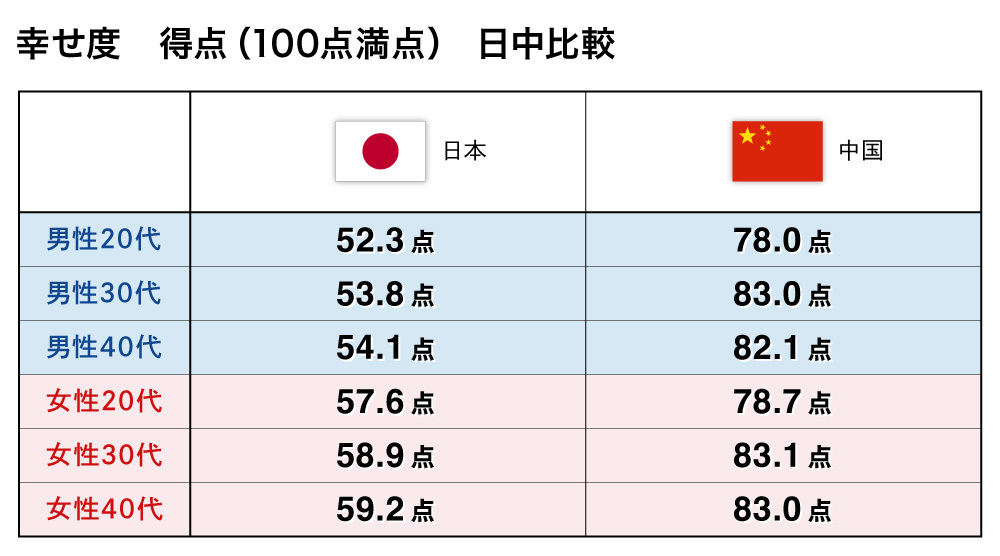The COVID-19 pandemic has triggered changes in people's health awareness and behaviors in China as well.
Dentsu Inc. Global Business Center surveyed key items from Dentsu Inc.'s "Wellness 10,000 Survey"—an insight study conducted in Japan for 16 years—in China in June 2022 (*).
Comparing these results with the Japanese survey ( conducted in 2021 ), we discovered some interesting gaps. Xue Qian (Setsu Sei), responsible for launching 'Dentsu Wellness China,' and Nao Takizawa, a planner specializing in the medical and healthcare field, will introduce some of these findings.
※The China version differs slightly in aspects such as respondent design. Details here.
In China, "Women in Their 30s" Have High Health Awareness! Differences in Daily Life Environments Between Japan and China
Xue: The Chinese "Wellness Survey" targeted 4,920 men and women aged 20-49 living in Tier 1 & New Tier 1 cities (※1). In China, those in their 20s to 40s form the core workforce driving high economic growth. They possess economic power and strong consumption capacity.
However, in recent years, attention has turned to the physical and mental health of this middle-class group, who face stress from long working hours epitomized by the "996" work culture (※2) and high living costs symbolized by soaring real estate prices.
※1 Tier-1 cities, New Tier-1 cities
Cities selected in the "2020 China Urban Development Level Ranking" jointly released by the China Urban Bureau and the China Urban Research Institute in 2020. Thirty-nine cities were designated as first-tier cities, with four of these being Tier 1 cities (Beijing, Shanghai, Guangzhou, Shenzhen). Additionally, 15 cities were designated as quasi-first-tier cities (Chengdu, Chongqing, Hangzhou, Xi'an, Wuhan, Suzhou, Zhengzhou, Nanjing, Tianjin, Changsha, Dongguan, Ningbo, Foshan, Hefei, Qingdao). The 2022 wellness survey also selected the same cities as first-tier and new first-tier cities as in 2020.
※2 "996"
Refers to working from 9 AM to 9 PM, six days a week—meaning 12-hour workdays with only one day off per week, typically Sunday.
Takizawa: While the Japanese version of the " Wellness 10,000-Person Survey " targeted men and women nationwide aged 20 to 60, resulting in a different demographic. For easier comparison, we'll present scores from the Japanese version focused on those aged 20 to 40.
Xue: First, let's look at the overall trends in "Health Awareness and Behavior." In China, women show slightly higher health awareness than men. Among women, those in their 30s stand out as having the highest awareness and most proactive behavior, indicating they actively engage in maintaining their health on a daily basis.
Takizawa: In Japan too, women generally have higher health awareness than men. But in China, it was surprising that awareness is highest among those in their 30s. In Japan, women become more proactive in health awareness and actions as they age. That is, those in their 60s are the age group with the highest awareness and practice. So why is it high among those in their 30s in China?
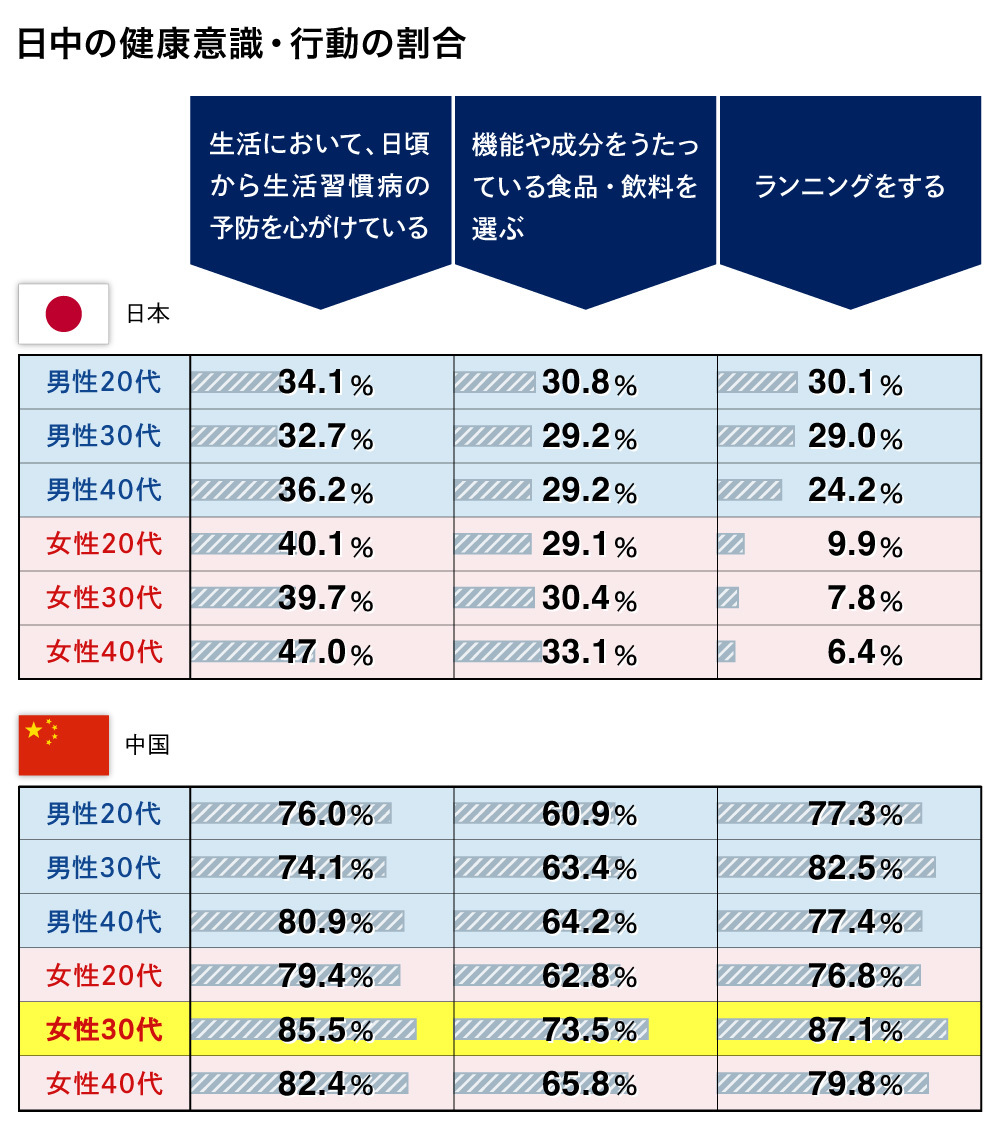
Scores are the sum of "Strongly agree" or "Somewhat agree" and "Always/often do" or "Sometimes do"

Supplements, health foods, drinks, etc.
Xue: In China, "health equals beauty," and Chinese women strongly believe that "beauty comes from within." Consequently, many women pay close attention to their diets and go to the gym for beauty. Among them, women in their 30s, who spent their youth during China's economic growth period, have financial power, are optimistic about the future, and spare no expense in investing in health and beauty.
Fundamentally, China has long promoted gender equality, and women who are independent and confident tend to be respected. Consequently, many women actively manage their health and physique to maintain the perception that they are still in their prime and on an upward trajectory.
Media influence also plays a significant role. Many women in their 30s follow the example of famous celebrities—mothers of two who continue strength training—who frequently post workout photos on social media. They share their own running photos or gym sessions on platforms like WeChat Moments or Douyin, projecting an image of a "healthy self."
Takizawa: Japanese women in their 20s and 30s also show strong health awareness and actions driven by beauty goals, but having children inevitably shifts priorities. I'm in my 30s myself, and observing those around me, life becomes child-centered, and for those working, balancing both seems to be a real challenge.
Xue: In China, however, even after marriage and childbirth, women often receive substantial support from domestic helpers or their own parents. This may foster a stronger mindset than in Japan, where they hesitate less to invest time and money in themselves.
China's advancing digitalization. In Japan, designing motivation for health app usage is urgent!
Takizawa: I knew China was ahead of Japan in digitalization within daily life, like the spread of cashless payments. But this time, we also saw a significant gap in the adoption rate of so-called health tech.
Take smartwatch usage rates, for example. In Japan, current usage among those in their 20s to 40s is only 12.8%, while in China, it's more than double that at 26.4%.
 Xue: In China, digital technology permeates every corner of daily life, and smartwatch usage is one example. There are also numerous health-related apps with very high usage rates. For instance, the usage rate for domestic apps like "Yuedong Circle" (※3) and "Keep" (※4) is around 30%.
Xue: In China, digital technology permeates every corner of daily life, and smartwatch usage is one example. There are also numerous health-related apps with very high usage rates. For instance, the usage rate for domestic apps like "Yuedong Circle" (※3) and "Keep" (※4) is around 30%.
※3 Yuedongquan: A Chinese health app with social features for recording and sharing runs
※4 Keep = A multifunctional health app in China
Takizawa: In Japan too, health apps for managing activity levels, weight, and diet are more commonly used than smartwatches. However, the large gap between the experience rate and current usage rate for any app suggests many people tried them once but stopped.
The most common reason for quitting health apps is "recording was too much hassle." People start using the app out of interest, but since they aren't seriously struggling with a problem, even a slight inconvenience in the process can easily lead them to quit. In Japan, we feel the difficulty of successfully designing motivation mechanisms on a daily basis.
Xue: In China, the main purposes for using health-related apps are "body shaping" and "improving physical constitution." However, the top reason for quitting is "having records but not knowing specific improvement methods," showing users seek visible "returns" for their efforts. The desire to showcase one's physique as a result of "health actions" seems stronger in China.
Takizawa: Next, regarding "online medical consultations," which gained attention during the pandemic. In Japan, even among younger generations aged 20-40, the usage rate remains low at just 5.6%. However, the intention to use it in the future reaches 34.3%, suggesting potential for adoption.
Xue: China had some online medical consultation usage even before COVID-19, but post-pandemic, the usage rate increased significantly. The usage experience rate among men and women in their 20s to 40s reached a very high 71.3%.
Furthermore, the usage rate for services where pharmacists explain prescriptions online and deliver them is also very high at 70.2%. I myself used "online medical consultations" this spring during Shanghai's lockdown period because I couldn't go to the hospital. I had my prescription issued online, and the entire process—including having the medication delivered to my home later—was completed quickly within a single app.
Differences in Consumption Rates of "Functional Ingredients" Between China and Japan
Takizawa: The comparison of ingredient lineups for health purposes and their consumption rates was also interesting. In Japan, "lactic acid bacteria" is a major presence, ranking higher than other ingredients in name recognition, consumption rate, and understanding of efficacy. But isn't it less talked about in China?
Xue: In recent years, awareness of lactic acid bacteria has increased, partly due to yogurt product advertising, but it's still lower compared to Japan. On the other hand, vitamins and protein are very well known, and supplements containing these are popular.
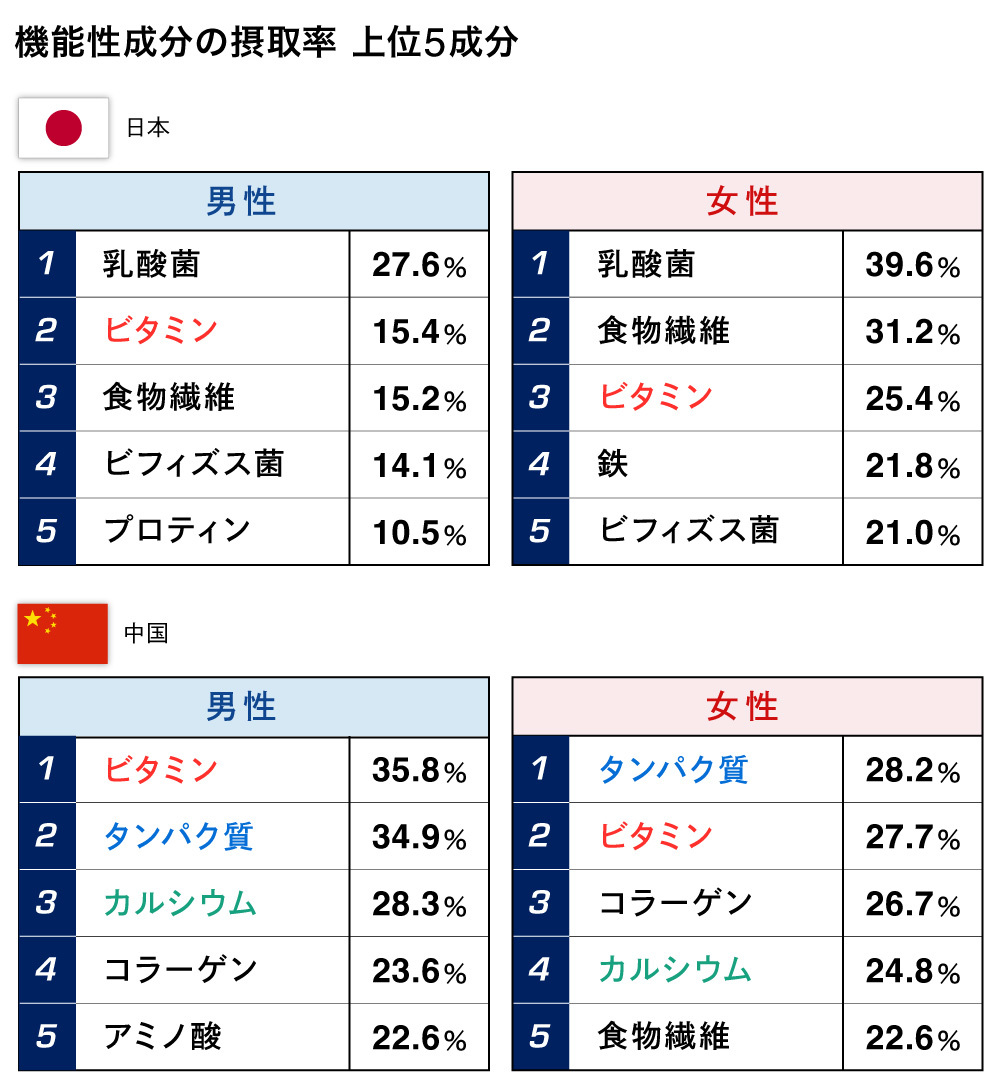
*To understand consumer awareness and comprehension, we included seemingly redundant ingredient names like "protein" and "protein powder" as separate options.
Takizawa: Another surprising point was the intake rate (volume). Looking at China's results by gender and age group, the highest intake rate among men in their 20s was 49.4% for protein and 42.4% for vitamins – meaning nearly half are consuming these functional ingredients. In Japan, the highest intake rate among men in their 20s is for lactic acid bacteria, but it's only 21.6%.
Compared to other age groups, people in their 20s are less likely to have health issues flagged by checkups. So, when looking only at Japan's results, it didn't feel unusual. But I was surprised to see that in China, taking functional ingredients as a "health action" is already established starting in their 20s.
Xue: That's right. In China, even young people in their 20s are increasingly focusing on health management. As exemplified by the trendy term "punk health preservation" (※5), they maintain unhealthy lifestyles yet obsess over health, seeking easily accessible, effective health solutions. Consequently, demand is high for vitamin and protein supplements and drinks as essential components for these young consumers.
※5 Punk Health
Meaning: A punk rock-style approach to health. A lifestyle that combines contradictory behaviors like "staying up all night while doing skincare" or "drinking cola mixed with Chinese herbal medicine" – essentially "overworking the body while pampering it."
The Talk of Well-Being Levels: Japan Shows Higher Levels Among Women Than Men, While China Shows No Gender Difference
Xue: Finally, let's look at the currently trending well-being index (a state of physical and mental health favorable to the individual). The concept of well-being is also gaining awareness in China, with a growing emphasis on comprehensively viewing people's wellness—not just physical health, but also mental health, relationships, and social engagement.
Takizawa: In Japan too, we see it increasingly in various places, like fashion magazines running well-being features. In our Wellness Survey of 10,000 people, we asked respondents to rate their "happiness level" over the past year on a scale of 100.
Xue: In China, the average score for men and women in their 20s to 40s was high at 81.9 points. Looking at gender and age groups, both men and women in their 30s and 40s scored higher, and the average scores for men and women were quite similar.
Takizawa: In Japan, scores gradually increase with age for both men and women. Comparing genders, women scored higher; for example, in their 40s, there was a 5-point difference between men and women.
■Summary
Health awareness and behaviors in Japan and China show differences reflecting each country's characteristics. We identified numerous findings that offer valuable insights for Japanese companies targeting the Chinese market and vice versa.
Dentsu Inc. will continue leveraging collaboration between healthcare projects in both countries to understand the healthcare market from a consumer perspective and support business development.
(Xue Qian)
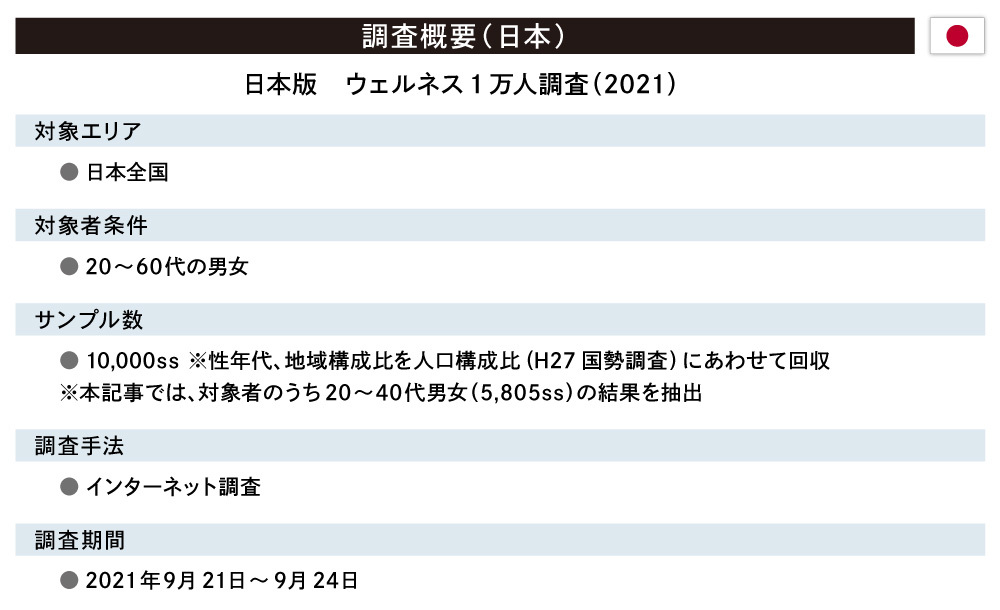






 Xue: In China, digital technology permeates every corner of daily life, and smartwatch usage is one example. There are also numerous health-related apps with very high usage rates. For instance, the usage rate for domestic apps like "Yuedong Circle" (※3) and "Keep" (※4) is around 30%.
Xue: In China, digital technology permeates every corner of daily life, and smartwatch usage is one example. There are also numerous health-related apps with very high usage rates. For instance, the usage rate for domestic apps like "Yuedong Circle" (※3) and "Keep" (※4) is around 30%.